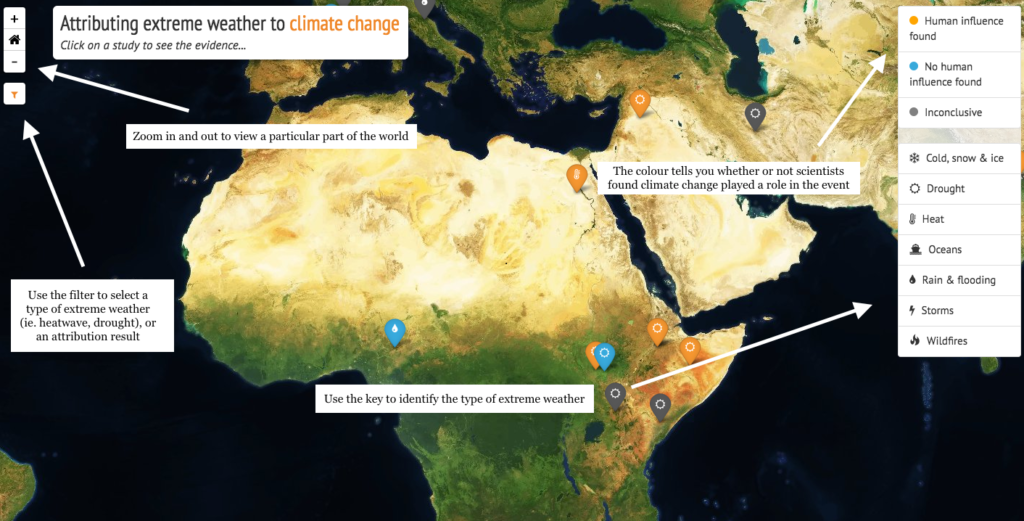This map shows extreme weather events in places influenced by human-made climate change

Lightning strikes over buildings during heavy rainfall in Kunshan, Jiangsu province, China in 2014 Image: REUTERS/Stringer

Get involved with our crowdsourced digital platform to deliver impact at scale
Stay up to date:
Climate Crisis
Tropical storms, hurricanes, fires and droughts have all made the headlines this year – but how can you find out if they are due to our species’ influence on changing weather patterns?
While we may never know the exact causes of an extreme weather event, a map on website Carbon Brief now shows 144 of them that have been written about in 138 peer-reviewed scientific studies into the effects of human activity on our climate.
Analysis of the results found that 63% of all the severe weather events featured on the map to date had been made more likely or more severe by human-caused climate change. “Heatwaves account for nearly half of such events (46%), droughts make up 21% and heavy rainfall or floods account for 14%,” the website said.
But could being able to accurately attribute blame for extreme weather events on the actions of companies and states become a concern for governments and business leaders in the court cases of the future?
A matter of attribution
Of the attribution studies conducted so far, scientists found that human-caused climate change has altered the likelihood or severity of an extreme weather event in 68% of cases studied (coloured orange in the main map).
Events that are featured include:
- Hurricane Sandy in 2012, which studies found was made more severe or likely to occur as a result of human influence.
- Heavy rainfall in Chennai, India, in 2015, where studies found no discernible evidence of human activity playing a part.
- And tropical cyclones in the Pacific in 2014, for which there was insufficient evidence to prove or disprove any links.

Ask the right questions
Of the 48 studies of extreme heat, 85% found climate change had made them more likely or more severe. Nearly a quarter of heat-related attribution studies focused on Australia, and all but one found human influence played a role.
This single study produced an inconclusive result for the city of Melbourne, but the authors “did detect a human influence on extreme heat just up the coast in Adelaide”.
As Carbon Brief pointed out: “This [result] raises a few important points. First, finding that climate change contributed to an event is not the same as saying it caused that event.
“Attribution is about working out if the chance of a particular event happening now is different from what it would be in a world that wasn’t warming.”
“A useful analogy... is of a baseball player who starts taking steroids. If the player begins hitting 20% more home runs than before, you can’t know for sure whether a particular home run is because of the steroids or the player’s spontaneous skill. But you can say how the steroids have altered the likelihood that the player hits a home run, by comparing their current and historical performances.”
No more ‘acts of God’?
A better public understanding of such nuances may be important in a world that looks for someone to be held accountable when catastrophe strikes.
An article in September’s Nature Geoscience, written by British and American lawyers, warned that company directors, politicians and those with a “duty of care” may in future be financially liable for events once seen as “acts of God”.
The article’s authors, Sophie Marjanac and James Thornton, of London-based ClientEarth, and Lindene Patton, of Washington DC-based Earth & Water Law, said: “The science of extreme weather attribution is improving rapidly, and is making important predictions about future weather events.
“This means the legal duties of those responsible for keeping people, the built environment and the natural world safe are changing too.
“Identifying the human influence in events once only understood as ‘acts of God’ will reshape the legal landscape, meaning governments and businesses could be sued if they don’t take action to protect people from floods, heatwaves and other foreseeable climate change risks.”
Such cases are already taking place. ClientEarth has twice taken the UK government to court in an attempt to make it reduce air pollution to legal limits and won on both occasions.
In the US, meanwhile, a group of young people is taking the Trump administration to court over climate change. The case was filed in 2015 on the grounds that despite knowing about climate change for decades, the federal government has not done enough to curb greenhouse gas emissions.
As the science behind extreme weather event attribution grows, executives and politicians seeking to deny responsibility by blaming a deity may get short shrift from the public.
General disclaimer: The designations employed and the presentation of material on this map do not imply the expression of any opinion on the part of the World Economic Forum concerning the legal status of any country, territory, city or area or of its authorities, or concerning the delimitation of its frontiers or boundaries.
Don't miss any update on this topic
Create a free account and access your personalized content collection with our latest publications and analyses.
License and Republishing
World Economic Forum articles may be republished in accordance with the Creative Commons Attribution-NonCommercial-NoDerivatives 4.0 International Public License, and in accordance with our Terms of Use.
The views expressed in this article are those of the author alone and not the World Economic Forum.
Related topics:
The Agenda Weekly
A weekly update of the most important issues driving the global agenda
You can unsubscribe at any time using the link in our emails. For more details, review our privacy policy.
More on Climate CrisisSee all
Mette Asmussen and Takahiro Furusaki
April 18, 2024
Laia Barbarà and Ameya Hadap
April 17, 2024
John Letzing
April 17, 2024
William Austin
April 17, 2024
Rebecca Geldard
April 17, 2024







